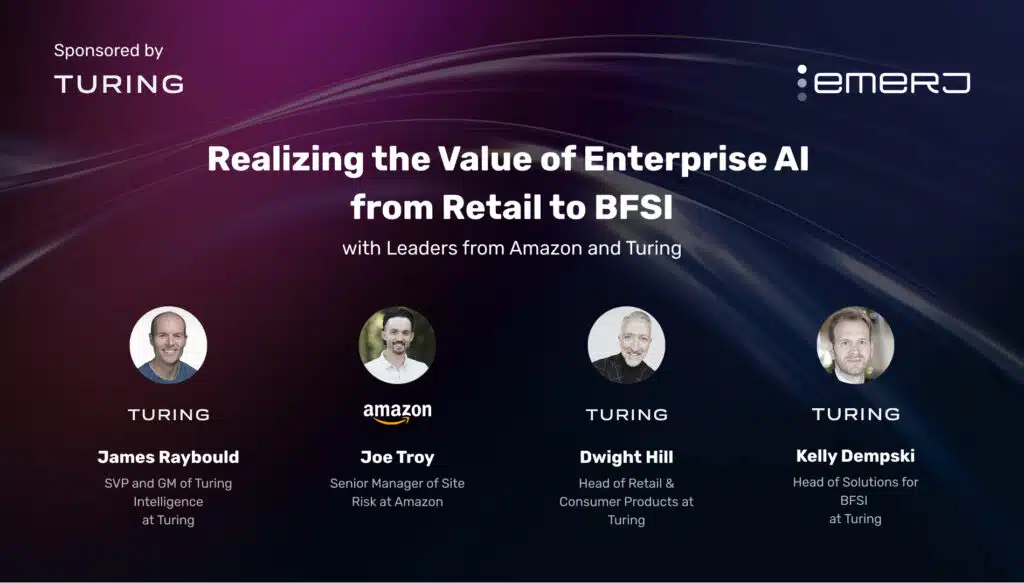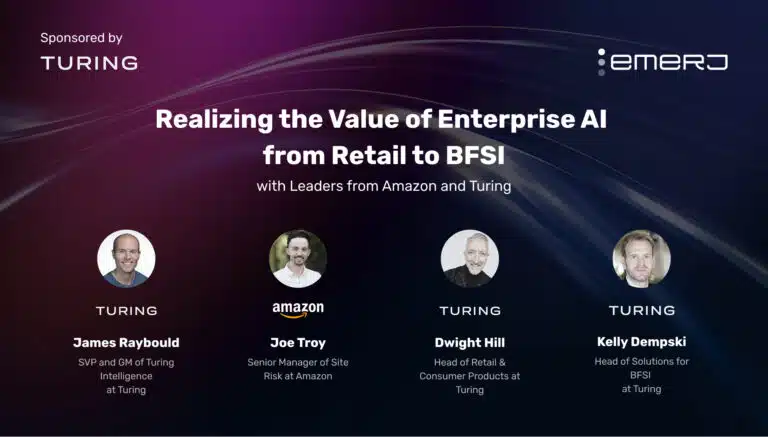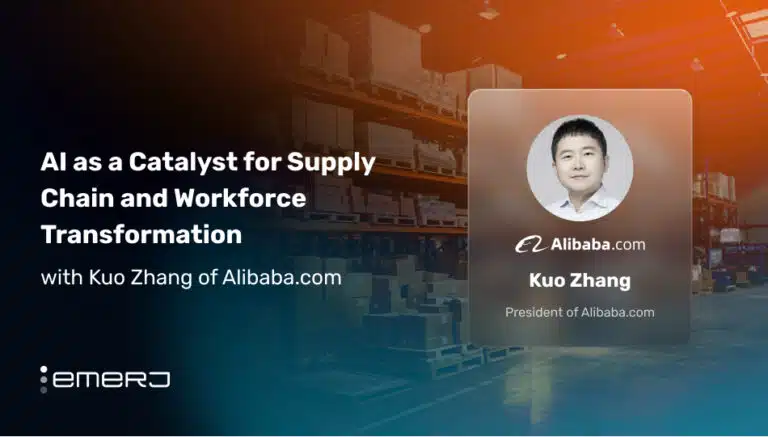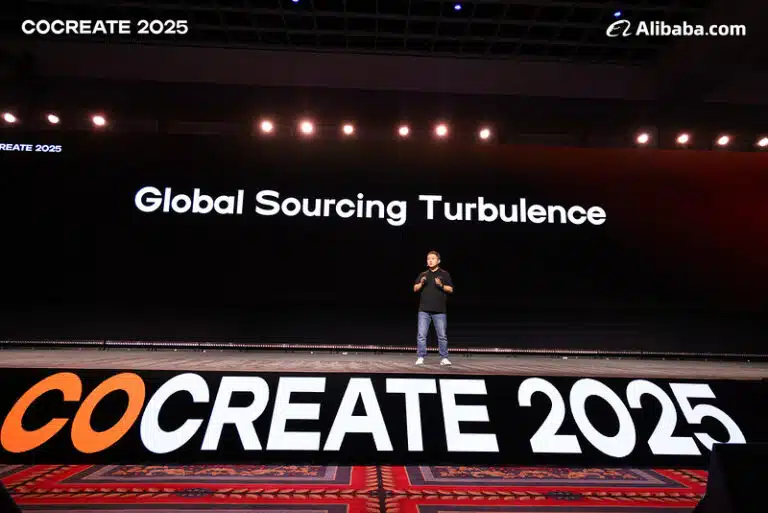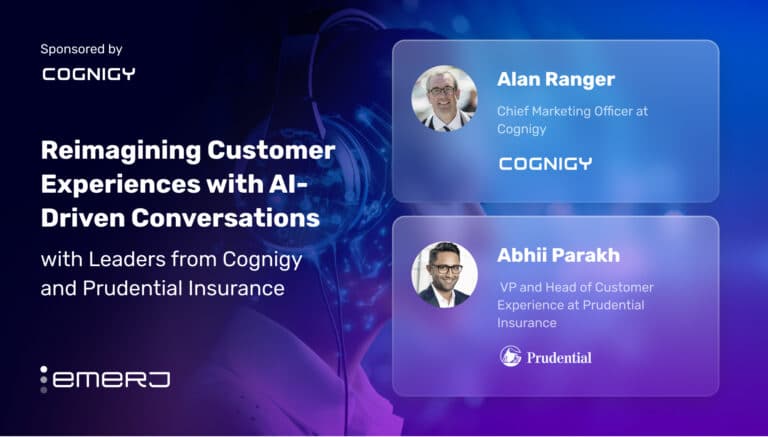This interview analysis is sponsored by Turing and was written, edited, and published in alignment with our Emerj sponsored content guidelines. Learn more about our thought leadership and content creation services on our Emerj Media Services page.
Despite operating in vastly different markets, retailers and BFSI (banking, financial services, and insurance) firms are racing to harness AI, and yet adoption strategies often look very different between organizations in the same industries. Still, some trends remain more constant: While financial services focus these advanced technologies on compliance-driven workflows and risk management, retail leaders are experimenting with customer engagement and inventory optimization.
The challenges these systems are designed to solve may not look more dissimilar to the unknowing observer. U.S. businesses spend between 1.3 % and 3.3% of their total wage bill on regulatory compliance tasks, a rise in “regulatory temperature” that significantly hampers productivity and forces firms to scale back growth initiatives.
Such regulatory bottlenecks are acutely felt in financial services, where compliance obligations, ranging from complex onboarding to fraud monitoring, absorb ever-larger swaths of talent and investment.
Meanwhile, retail organizations face a more existential threat: shrinkage. The National Retail Federation estimated a staggering $100 billion in inventory losses in 2022, equivalent to about 1.5 % of total U.S. retail sales, a blow that severely erodes already razor-thin margins. Retail shrinkage stems from theft, fraud, and errors — and in many cases, internal contributors cause greater losses than external actors.
Looking at these challenges therein through a data-driven lens reveals that the technologies enabling each sector are often very similar in application often overlap.
As studies show consistently, more deterministic AI solutions that streamline regulatory processes in BFSI increasingly resemble the tools driving personalization, supply chain efficiency, and predictive inventory management in retail. For business leaders, these parallels highlight opportunities to borrow proven approaches across sectors and turn advanced technology into measurable business results.
In the following analysis of conversations on Emerj’s ‘AI in Business’ podcast, we take a closer look at how leaders in BFSI and retail are grappling with the realities of enterprise AI adoption. Across these industries, organizations face mounting pressure to modernize data infrastructure, integrate AI into legacy systems, and demonstrate measurable returns on investment—while navigating regulatory demands and customer expectations.
The series features executives with deep expertise in both AI deployment and domain-specific business challenges, including James Raybould, SVP and GM of Turing Intelligence at Turing; Dwight Hill, Head of Retail & Consumer Products at Turing; Kelly Dempski, Head of Solutions for BFSI at Turing; and Joe Troy, Senior Manager of Site Risk at Amazon.
This article synthesizes the conversations from the podcast series into three critical insights for leaders seeking to realize business value from enterprise AI initiatives:
- Scaling enterprise AI through responsible governance: Establishing clear frameworks for helping organizations deploy AI across business units safely and efficiently, ensuring innovation aligns with compliance, risk management, and strategic objectives.
- Accelerating retail & CPG transformation through targeted AI use cases: Applying AI to existing retail and consumer engagement workflows in site risk management and inventory optimization deliver measurable ROI quickly while supporting broader digital transformation goals.
- Realizing BFSI AI value through problem-first implementation: Starting with high-impact financial services challenges like onboarding and document intelligence enables firms to achieve early wins, optimize legacy system integration, and scale AI initiatives strategically over time.
Scaling Enterprise AI Through Responsible Governance
Episode 1 – The AI-Minded Path to Scalable and Responsible Innovation Across the Enterprise – with James Raybould of Turing Intelligence
Guest: James Raybould, SVP and GM of Turing Intelligence at Turing
Expertise: AI strategy, Product leadership, Fractional executive roles, Startup growth, Technology business scaling
Brief Recognition: Former senior leader at LinkedIn, where he led product management, sales strategy, and key acquisitions including Lynda.com and Glint; fractional executive at multiple AI startups; holds an MBA from Harvard Business School.
James Raybould begins his podcast appearance by emphasizing that successful AI adoption in enterprises is never just about the technology itself. He notes the importance of aligning AI initiatives with real business problems, preparing teams for new workflows, and establishing infrastructure that supports security and compliance.
These elements form the foundation of responsible governance in AI deployments. James explains with examples from his work at Turing that, without such frameworks, organizations risk misaligned priorities, underutilized tools, or inefficient operations despite the power of the technology at hand:
“What Turing spent a lot of time working with customers on is that it’s not that AI is perfect out of the gate. It’s that we work with your team, we understand what your use case is, and then we build a human loop system where we’re not going to come in and say let’s automate everything on day one.
We start with humans verifying information and training the model, and over time, humans verify a little less and less. Then, what used to be primarily a human-generated task becomes more likely to be done through AI.
That’s where the expertise in both domains is crucial — knowing where AI is already amazing, and where human oversight is required to deliver on the promise of your business goals.”
— James Raybould, SVP and GM of Turing Intelligence at Turing
His approach reflects a core principle of enterprise AI governance: integrating humans in the loop to maintain quality, accountability, and measurable outcomes.
By initially combining AI capabilities with human judgment, James insists organizations can safely scale AI applications across departments while preserving compliance and operational integrity. The phased deployment then allows teams to adapt gradually, mitigating risks associated with over-automation or untested AI solutions.
Raybould’s insight underscores that structured frameworks must address three critical dimensions: business alignment, workforce readiness, and infrastructure robustness.
To achieve business alignment, James explains to the Emerj podcast audience that leading with the business problem ensures AI adoption generates real value rather than deploying technology for its own sake.
He notes that companies frequently stumble when they treat AI solely as a technical problem, bypassing the context of customer needs, operational realities, and strategic objectives. A governance framework that ties AI outcomes to business metrics keeps initiatives purposeful and measurable.
Workforce readiness is the second dimension of Raybould’s framework. Beyond initial human verification, he emphasizes preparing teams to interact effectively with AI-driven workflows, understanding new decision-making responsibilities, and adapting to evolving roles.
Change management and cultural adaptation are crucial: employees must see AI as a tool that augments rather than replaces their expertise. By embedding training, clear processes, and measurable adoption metrics, organizations can maintain accountability while scaling AI solutions across departments.
The final dimension James explains is infrastructure and compliance. Scaling AI across multiple business units requires systems that are secure, auditable, and capable of handling diverse data sources.
For Raybould at Turing, governance frameworks should integrate policies for data access, privacy, and oversight, ensuring that AI deployment meets regulatory standards while providing measurable business outcomes.
His discussion of the “human loop system” illustrates how infrastructure and governance intersect. In practice, AI outputs are:
- Monitored for accuracy and consistency
- Validated against human judgment and business rules
- Improved iteratively as the system learns from ongoing feedback
This approach bridges the gap between cutting-edge technology and operational reliability, ensuring that AI deployments remain effective, accountable, and aligned with organizational goals.
Additionally, organizations benefit from embedding metrics and monitoring into AI frameworks from the outset. By tracking adoption rates, task efficiency, error rates, and business impact, leaders can evaluate both the performance of the AI system and the readiness of the workforce engaging with it. Raybould points out that starting small with deterministic or narrowly scoped applications allows companies to gather real data on outcomes, informing scalable strategies for broader AI integration.
Importantly, Raybould’s perspective demonstrates that responsible governance cannot be static: As AI capabilities evolve, governance frameworks must also adapt.
James also notes that continuous evaluation, iterative deployment, and alignment with business priorities help enterprises maintain trust in AI systems while expanding their scope of use. The combination of human oversight, clearly defined goals, and robust infrastructure ensures that scaling AI does not compromise quality, compliance, or employee engagement.
In practice, a monitored “human loop” approach means that AI adoption can progress along a measured path: beginning with small, high-value use cases, integrating human verification, capturing data on outcomes, and then expanding to wider applications.
By following Raybould’s principles, organizations can approach AI adoption in a structured, human-centered way:
- Preserve accountability and control – Start small with high-value use cases and integrate human verification to ensure outcomes remain accurate and reliable.
- Facilitate cultural adaptation – Gradually introduce AI workflows so employees understand and embrace new ways of working alongside technology.
- Bridge experimentation to enterprise scale – Use lessons from small deployments to expand AI across departments, maintaining alignment with business priorities.
- Ensure responsible governance – Combine strategic alignment, workforce readiness, and robust infrastructure to deliver measurable business impact.
Accelerating Retail & CPG Transformation Through Targeted AI Use Cases
Episode 2 – Accelerating Retail & CPG Transformation through AI Solutions – with Dwight Hill of Turing, and Joe Troy of Amazon
Guest: Joe Troy, Senior Manager of Site Risk at Amazon
Expertise: Retail risk management, Loss prevention strategy, Operational risk assessment, Security and asset protection
Brief Recognition: Previously, Joe Troy held senior loss prevention and asset protection roles at Walmart and J.Crew, with additional leadership experience at Rent The Runway and Toys”R”Us; before joining Amazon, leading site and operational risk across North America; holds an MBA in Accounting and Finance from SMU Cox School of Business.
Guest: Dwight Hill, Head of Retail & Consumer Products at Turing
Expertise: Retail growth strategy, Business development leadership, Client engagement and transformation
Brief Recognition: Former Global Client Partner at Publicis Sapient, leading digital transformation and growth for major retail clients; extensive experience in business development and client engagement; holds a Certificate in Artificial Intelligence for Business Leaders from Texas McCombs School of Business.
Joe Troy begins his conversation with Turing Head of Retail & Consumer Products, Dwight Hill, by explaining how generative AI is augmenting loss prevention and operational efficiency across retail operations. Rather than replacing human teams, he explains at length how AI models enhance human oversight activities by surface anomalies in surveillance footage, highlight unusual traffic in restricted areas, and reduce investigation time.
These new automated advantages allows loss prevention teams to act with greater precision while aligning operational goals such as staffing optimization and marketing placement:
“Something we’re seeing more now is the use of behavioral and device intelligence during the hiring process.
So if you think about pre employment risk assessments, they can help to identify potential insider threats before they enter the organization, and this proactive approach is where AI is really shining. We’re moving from a reactive to a preventative loss strategy.
When we talk about ROI, it’s not just dollar saved from reduced theft, it’s also time saved labor, reallocated and better alignment across the function. I think it’s helping to create a more holistic impact, and not just departmental impact.”
— Joe Troy, Senior Manager of Site Risk at Amazon
In turn, Dwight Hill points to personalization as a particularly strong opportunity, with conversion lifts of 20% or more in in-store and online applications. AI-enabled campaign management allows marketing teams to target micro-segments with the right product, price, and timing, improving both customer experience and operational efficiency.
Before launching AI initiatives, Dwight emphasizes that leaders should focus on real business problems and data readiness rather than chasing the next shiny object. He suggests asking critical questions upfront:
Questions to ask at the start of an AI initiative:
- Do you have an integrated, unified data strategy?
- Is your data cleansed and ready for AI use?
- Are there silos or other barriers to accessing key datasets?
- What challenges exist with the data that might prevent AI from delivering results?
“You need to think about what is really the overall strategy. So do you have a strategy around AI? And even if you don’t, do you have a specific use case that makes sense from a testing point of view.”
— Dwight Hill, Head of Retail & Consumer Products at Turing
Troy then validates that practical near-term AI opportunities are clear across retail operations by identifying three areas of immediate impact:
- Pre-employment behavioral screening to reduce insider risk
- Personalized and intelligent alerting for frontline associates
- Enhanced inventory and pricing optimization.
Behavioral screening surfaces risks before onboarding, intelligent alerts guide employees in real time, and integrated AI across merchandising, supply chain, and marketing supports faster, smarter decision-making.
The conversation underscores that leadership engagement drives AI success. Leaders must encourage data literacy, break down silos, and ensure alignment between operational and risk teams. Pilots succeed when initiatives are guided by clear use cases, measurable ROI, and active collaboration.
Organizations that focus on clean, unified data, strategic planning, and human-in-the-loop frameworks see measurable benefits not only in loss prevention but also in marketing effectiveness, store operations, and personalized customer experiences.
By embedding AI into core workflows and aligning teams around shared goals, retail and CPG organizations can transform fragmented initiatives into high-impact programs. Insights from Troy and Hill demonstrate that AI adoption is about more than automation — it’s about elevating human decision-making, fostering cross-functional collaboration, and unlocking actionable outcomes that leaders can implement immediately.
Realizing BFSI AI Value Through Problem-First Implementation
Episode 3 – Turning AI Vision Into Value in Financial Services – with Kelly Dempski of Turing
Guest: Kelly Dempski, Head of Solutions for BFSI at Turing
Expertise: AI Solutions for Financial Services, Banking Technology Innovation, Enterprise AI Strategy, Document Intelligence Systems
Brief Recognition: Previously Managing Director at Citi, leading North American retail bank and mortgage technology, and VP of Digital Business Solutions at SoftServe, advising CIO/CTO clients on product definition, compliance, and AI-driven technology modernization.
Turing Head of Solutions for BFSI Kelly Dempski frames the AI adoption conversation around practical, problem-first applications of these capabilities in financial services, emphasizing that measurable ROI comes from solving existing challenges rather than chasing AI for its own sake.
He affirms BFSI listeners who are under pressure to accelerate processes, cut costs, and maintain compliance before outlining how AI can be applied to achieve these outcomes.
Several high-value use cases where Dempski says financial institutions are already seeing results: onboarding, fraud detection, process automation, and document intelligence.
- Onboarding
- Client and transaction vetting
- Process automation
- Document intelligence
By starting with clearly defined problems around slower processes in these categories, Kelly describes how organizations can achieve early wins and build momentum toward more complex, scaled AI initiatives:
“One should first say, look, what are my hardest problems? What are the things that I’m most challenged by? Where maybe the highest cost, maybe the highest customer dissatisfaction.
Then say, ‘Great, out of all of those things that I’m doing, where can I bring AI into the system? Where can I have AI solve maybe a piece of the puzzle, or a larger and larger set of pieces of the puzzle?’
Then that brings us back to kind of quick wins, or sort of advancing over time. Where today, you may be able to build a solution that handles 10% of the customers more effectively, because it’s a 10% that has a particular set of issues or particular set of challenges. Then over time, you take another 10% another 10% another 10% and you are able to solve much greater set of challenges.”
— Kelly Dempski, Head of Solutions for BFSI at Turing
Dempski then explains that one of the primary sources of complexity in BFSI AI adoption lies not in the models themselves, but in integrating them with legacy systems and navigating data access hurdles.
Many organizations have critical information siloed across multiple platforms, some of which are decades old. Moving data safely and efficiently from core systems to AI-enabled platforms can be more challenging than developing the AI models themselves. He argues that core incongruence underscores the importance of understanding system architecture, compliance requirements, and operational workflows before designing AI solutions.
From an operational perspective, process automation is one of the most immediately impactful areas for AI. Dempski notes that repetitive, rule-based tasks — whether internal back-office processes or customer-facing document verification — can be streamlined with deterministic AI, reducing human error and freeing employees for higher-value work.
Similarly, AI enhances transaction monitoring, credit risk assessment, and compliance processes by rapidly analyzing large datasets, uncovering patterns and anomalies that might elude manual review. For BFSI leaders, these applications offer measurable efficiency gains while maintaining operational reliability and regulatory standards.
In pursuing problem-first approaches to AI adoption, Dempski also cautions against pursuing overly ambitious implementations without incremental progress.
Attempting to solve 80–100% of a problem in a first AI deployment can be technically and operationally challenging. Instead, Dempski advocates for starting with smaller, high-value slices of a problem that allows teams to validate the AI approach, generate measurable results, and build confidence. Over time, organizations can expand the solution incrementally, gradually addressing a larger portion of the problem while maintaining operational control and compliance integrity.
He also highlights the critical role of data strategy in BFSI AI success. Clean, well-structured, and accessible data is a prerequisite for meaningful outcomes.
Dempski warns that AI adoption often stalls not because models fail, but because data pipelines, integration points, and governance frameworks are insufficiently prepared. Leaders can avoid these pitfalls by:
- Building robust data infrastructure to ensure AI systems have reliable, unified access to information.
- Monitoring and validating AI outputs to maintain accuracy, consistency, and operational reliability.
- Integrating regulatory and compliance requirements directly into AI workflows to safeguard legal and ethical standards.
Dempski’s perspective provides a practical roadmap for BFSI executives seeking to harness AI along four pillars:
- Starting small: Begin with manageable, well-defined projects – ‘trying to do 10% of a hard problem better.’
- Focus on high-value problems: Target areas where AI can deliver measurable impact.
- Ensure data accessibility and integration: Make sure systems and data sources are connected and usable.
- Scale incrementally: Expand AI applications gradually as capabilities and confidence grow.
Finally, Dempski reinforces the importance of organizational alignment. Cross-functional collaboration between technology, compliance, and business teams ensures that AI systems are not only technically robust but also operationally meaningful.
He emphasizes that leaders who communicate early wins, demonstrate ROI, and maintain a clear focus on solving defined business problems create an environment where AI adoption can grow sustainably. In setting the foundation of deployment on these pillars, BFSI firms can capture real AI value today — not by pursuing futuristic applications — but by systematically embedding AI into existing priorities and workflows.

